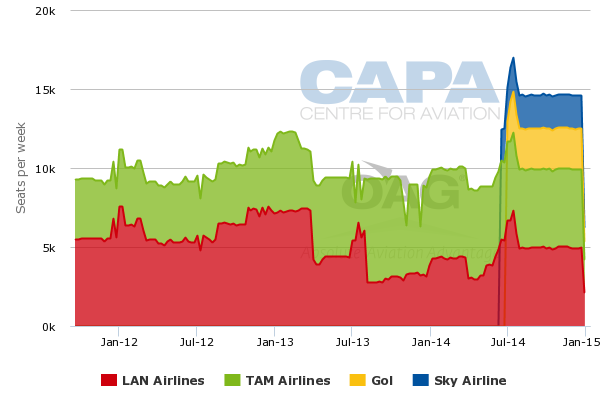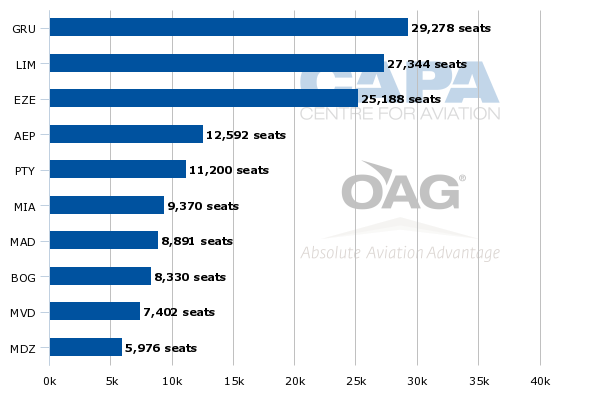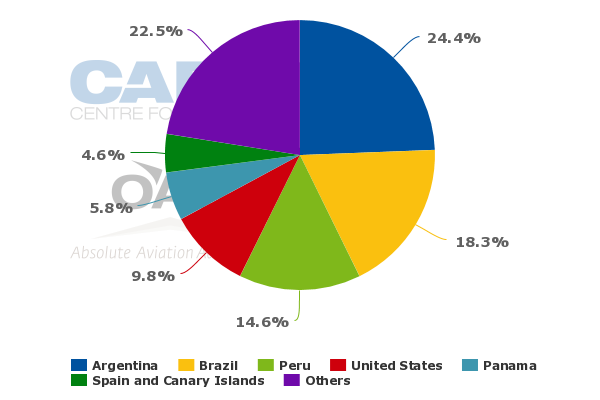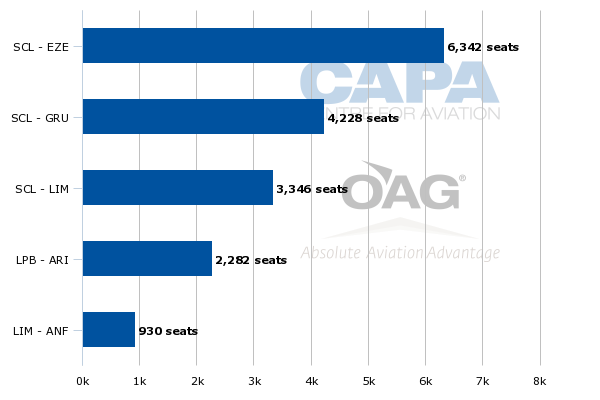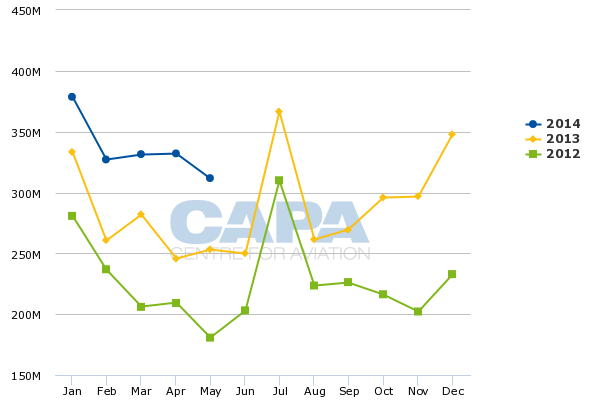Chile-Brazil airline market poised for growth as Gol and Sky Airline break LAN-TAM's monopoly
The Chile-Brazil market is poised for rapid growth as competition has intensified, leading to an over 50% increase in capacity. Brazil's Gol and Chile's Sky Airline have both launched services on the Santiago-Sao Paulo route, breaking the monopoly of LATAM Airlines Group.
Gol and Sky have both been pursuing international expansion and could add other Chile-Brazil routes in 2015. LATAM is still the only non-stop operator between Santiago and Rio de Janeiro and is also planning to launch in late 2014 Santiago-Porto Alegre, a route previously served by Gol.
Sao Paulo is only the fourth international destination for Sky while Santiago has become the 15th international destination for Gol. There are more opportunities for both carriers in the international market but competing with powerful LATAM could prove challenging.
LATAM still has a 70% share of capacity in Santiago-Sao Paulo market
Sao Paulo Guarulhos is the largest international destination from Santiago. The route is currently served with 88 weekly frequencies and about 16,000 one-way seats, according to CAPA and OAG data.
Chile-based LAN Airlines is the market leader with five to six daily flights while Brazilian sister carrier TAM has three daily frequencies. But LAN's current schedule includes a temporary seasonal increase for June and July as the carrier has added flights to Sao Paulo for the 2014 FIFA World Cup. LAN will return to its normal schedule of four daily flights in Aug-2014 while TAM will continue with its normal schedule of three daily flights, according to OAG data.
LAN and TAM combined currently have about 11,700 one-way seats in the Santiago-Sao Paulo market, which will be reduced to slightly less than 10,000 seats in Aug-2014 as LAN reverts back to four daily flights. LAN and TAM both operate one daily widebody flight on the Santiago-Sao Paulo route with all the other flights operated with A320 family aircraft. LATAM currently accounts for about a 71% share of capacity between Santiago and Sao Paulo.
Sky entered the market at the end of Mar-2014 with one daily A319 flight. It added a second frequency in Jun-2014 and currently provides about 2,100 weekly one-way seats, giving it about a 13% share of capacity. (Sky's share will increase to almost 15% in Aug-2014 as LAN cuts back to four daily flights.)
Gol resumed services to Santiago on 3-Jul-2014 with two daily 737-800 flights. It previously served Santiago from 2006 to 2012 but dropped non-stop flights to Sao Paulo several years ago. When it pulled out of the Santiago market in 2012 Gol was serving the Chilean capital from Buenos Aires in Argentina and Porto Alegre in southern Brazil (with the flights originating in Rio de Janeiro and Sao Paulo).
Gol's new non-stop flights now provide about 2,500 weekly one-way seats between Santiago and Sao Paulo, accounting for about a 16% share of total seat capacity in the market. Gol's share will increase to almost 18% in Aug-2014.
Santiago to Sao Paulo capacity route total (one-way seats per week): 19-Sep-2011 to 4-Jan-2015
Chilean authorities were concerned with LATAM's monopoly on Santiago-Sao Paulo
LAN and TAM had for several years been the only airlines with non-stop flights in the Santiago-Sao Paulo market. Their merger, which was completed in mid-2012, gave new parent company LATAM a monopoly in the market.
One-stop competition in the Santiago-Sao Paulo market was also reduced in 2012 as Gol dropped its one-stop service and Uruguay's Pluna suspended operations. Pluna was one of the main one-stop competitors in the market as it offered multiple daily flights to both Santiago and Sao Paulo and relied heavily on sixth freedom traffic between Chile and Brazil as well as Argentina and Brazil.
The lack of competition in the Santiago-Sao Paulo market emerged as an issue when Chilean anti-trust authority TDLC began reviewing the LAN-TAM merger proposal after the deal was forged in Aug-2010. In an attempt to appease Chilean authorities LATAM offered slots at Guarulhos Airport to any new entrant on the Santiago-Sao Paulo route.
LATAM also offered to interline or codeshare and forge a frequent flyer link with any new entrant. This unusual move was an attempt to persuade a potential new entrant who may be concerned they would lack the schedule and capacity to compete with LATAM, particularly for business passengers.
See related report: LAN-TAM concessions to increase competition on Santiago-Sao Paulo route
The TDLC eventually approved the deal with several mitigation measures. Included in these measures was the divestment of four slot pairs at Guarulhos. The TDLC also required LAN and TAM to interline with any airline interested in serving Santiago-Sao Paulo and two much smaller LATAM monopoly routes, Santiago to Rio de Janeiro and Asuncion in Paraguay.
As part of its Sep-2011 decision the TDCL also required LAN to give up some of its traffic rights on Santiago-Lima to other Chilean carriers although this route already had some competition including from Sky and Avianca. TDLC also stipulated that LATAM subsidiaries can only be in one global alliance, which eventually led to TAM's decision to exit Star for oneworld.
See related report: oneworld favoured with more at stake than Star in LAN-TAM alliance decision
In the first two years after the TDLC mitigation measures were announced no carrier moved to launch flights from Santiago to Sao Paulo or in the smaller Santiago to Rio de Janeiro and Asuncion markets. The offer of slots and an interline arrangement were not enough initially to entice airlines to compete with LATAM. Sky and Gol finally decided earlier this year to enter the Santiago-Sao Paulo market using the slots offered by LATAM.
The decision by Gol and Sky to launch Santiago-Sao Paulo was driven not so much by the opportunity to take over from a competitor some slots at Guarulhos or the desire by Chilean authorities to have competition in one of Chile's largest international markets as by where Gol and Sky, the second largest carriers in Brazil and Chile after TAM and LAN, are with their network strategies. Both carriers are now seeking to expand their international networks and were attracted by the growing economic ties and traffic between Chile and Brazil.
Capacity increases by over 50% on Santiago-Sao Paulo route
Growth in the Chile-Brazil market should be accelerated as the new competition results in lower average fares, stimulating new demand. With both Gol and Sky launching services on Santiago-Sao Paulo there has been a rapid increase in capacity. Based on Aug-2014 capacity levels, total seat capacity in the Santiago-Sao Paulo market is up 57% on a year over year basis from about 9,300 to about 14,600 one-way seats.
The capacity increase brought out by Sky and Gol has resulted in Sao Paulo Guarulhos overtaking Lima and Buenos Aires Ezeiza as the largest international route from Santiago. But when including both Buenos Aires airports, Aeroparque (AEP) and Ezeiza (EZE), Buenos Aires is still the largest market from Santiago.
The Santiago-Buenos Aires market already has significant competition. While LAN has subsidiaries or affiliates in both Chile and Argentina, the Santiago-Buenos Aires market is also served by Aerolineas Argentinas and Sky, which began serving Buenos Aires in late 2010. Air Canada and KLM also serve the Santiago-Buenos Aires market as part of long-haul flights originating in Toronto and Amsterdam with pick-up rights at Ezeiza.
Top 10 international routes from Santiago ranked by seat capacity: 4-Aug-2014 to 10-Aug-2014
LATAM currently faces competition on eight of the top 10 routes from Santiago - Sao Paulo (now that Sky and Gol have entered), Lima, both Buenos Aires airports, Miami, Bogota, Madrid and Montevideo. Only to Mendoza in Argentina, which is the 10th largest international route from Santiago, is LAN now the only operator.
(Panama City, which the fifth largest international route from Santiago based on seat capacity, is only served by Copa Airlines. Copa has five daily flights to Santiago with most passengers connecting beyond Panama City to other destinations in the Americas.)
Santiago-Rio de Janeiro remains a LATAM monopoly - for now
Rio de Janeiro, the 11th largest destination from Santiago based on Aug-2014 seat capacity levels, is also only served by LATAM.
The Santiago-Rio route is now served with three daily LAN flights and three weekly TAM flights. But as is the case with Sao Paulo LAN has added extra flights to Rio de Janeiro for the 2014 World Cup and will revert back to nine weekly frequencies in Aug-2014 while TAM will maintain its three frequencies. (All of LATAM's flights between Santiago and Rio are operated with A320 family aircraft.)
Brazil overall is the second largest international market from Chile after Argentina. Based on Aug-2014 capacity levels, Brazil accounts for about 18% of total international capacity while Argentina accounts for 24%.
Chile international capacity share (% of seats) by country: 4-Aug-2014 to 10-Aug-2014
In Aug-2014 there will be 96 weekly frequencies in the Chile-Brazil market (84 to Sao Paulo and 12 to Rio de Janeiro) and about 17,700 one-way weekly seats, according to CAPA and OAG data. This represents a 53% increase compared to the 11,600 weekly one-way seats from Aug-2012.
There will likely be further growth in the Chile-Brazil market over the next year as Gol, Sky and LATAM have all been evaluating potential new routes between the two countries.
Sky Airline may launch more Brazil routes in 2015
Sky has indicated it is looking at Rio de Janeiro, Brasilia and Porto Alegre as part of a broader plan to expand its international operation. Its next international route is expected to be launched in 2015 as the focus is now on consolidating its position in the Santiago-Sao Paulo market.
Sky is predominately a domestic carrier. In its first push in establishing an international operation at Santiago, Sky launched services on the Santiago-Buenos Aires and Santiago-Lima routes in late 2010.
Previously Sky's only international routes were from secondary cities in northern Chile - Antofagasta-Lima and Arequipa-La Paz (Bolivia). Antofagasta-Lima is now served three times per week while Arica-La Paz is served daily (with the flight originating in Santiago). Santiago-Buenos Aires is Sky's largest international route, with three daily flights, while Santiago-Lima is served with 11 weekly flights.
Sky Airline international routes ranked by seat capacity: 7-Jul-2014 to 13-Jul-2014
Sky now has about a 6% share of Chile's international market compared to about 63% for LATAM. (The LATAM figure includes LATAM affiliates in all countries; not just Brazil and Chile.)
But Sky's international share has been on the rise. Through the first five months of 2014 Sky's international passenger traffic was up 16% to 169,000 passengers, according to Chile JAC data.
Total international passenger traffic in Chile was up only 2% in the first five months of 2014 to 3.1 million. As a result Sky's share of the Chilean international market has increased from 4.8% in the first five months of 2013 to 5.5% in the first four months of 2014.
Chile international passenger traffic for top 10 carriers: 5M2014 vs 5M2013 and May-2014 vs May-2013
Sky Airline to start focusing more on international market
Sky also captured 23% of Chile's domestic market in the first five months of 2014 as its domestic passenger numbers increased by 16% to 965,000. As CAPA previously analysed, the rate of traffic growth in Chile's domestic market has slowed down significantly this year. Total domestic traffic was up only 6% in the first five months of 2014, including 3% in May-2014. Chile's domestic market has recorded four consecutive years of high double digit growth including 14% in 2013, 19% in 2012, 18% in 2011 and 18% in 2010.
See related report: LAN Airlines cuts Chile domestic capacity, as World Cup traffic slump adds another hurdle for LATAM
Sky and LAN are now expecting domestic passenger growth to be in the low single digits for the full year in 2014 due in part to Chile's weakening economy. With domestic expansion opportunities limited, it is sensible for Sky to focus more on the international market, where there has been more robust growth in recent months including 8% in May-2014. Sky has always had ambitions for a bigger international network but took a hiatus from expanding its international network in 2013 as domestic market conditions were favourable.
Significant international expansion is expected over the next three years - albeit at a relatively low base - as Sky plans to grow its fleet to 23 aircraft by 2018. The carrier currently operates a fleet of 16 A320 family aircraft consisting of 12 A319s and four A320s, according to the CAPA Fleet Database.
Sky also aims to double its passenger traffic from 2.5 million in 2013 to 5 million by 2018. While there will be opportunities to further expand in the domestic market, which accounted for 2.1 million of the 2.5 million passengers in 2013, international traffic will likely grow at a faster rate.
Brazil is the most logical growth market for Sky as opportunities to expand in Argentina, which is Chile's other major international market, are limited due to bilateral constraints. Sky already serves Peru with two routes and most of the other main markets from Chile are not within narrowbody range.
Peru is currently Chile's third largest international market after Argentina and Brazil. The other two top five markets, the US and Spain, would require widebodies. As Sky does not have intentions of expanding into widebody aircraft focusing international expansion on Brazil as it continues expanding its fleet of A320 family aircraft is the most likely strategy.
Gol also increases its focus on international market
Gol also has been increasing its focus on the international market over the last couple of years as conditions in Brazil's domestic market have been relatively less favourable. Gol's international RPKs were up by 22% in the first five months of 2014, including 23% in May-2014.
Gol monthly international RPKs: Jan-2012 to May-2014
The resumption of service to Santiago is the latest in a string of new or resumed international routes for Gol, which now serves 13 international destinations in South America and the Caribbean as well as two in the US.
Sao Paulo-Santiago immediately became Gol's second largest international route. Only Sao Paulo-Buenos Aires Aeroparque, which is served with three daily flights, is bigger. All of Gol's other international routes are served with 12 weekly frequencies or less.
Gol top 10 international routes ranked by seat capacity: 7-Jul-2014 to 13-Jul-2014
There are still opportunities for further international growth as TAM still accounted for an 86% share of international RPKs flown by Brazilian carriers in the first five months of 2014, according to Brazilian ANAC data. Gol has gained ground over the last year as its share has increased from 12% to 14%. There is still a lot of room to grow even if Gol sticks with its all-narrowbody fleet and even with Azul planning to become in late 2014 the third Brazilian carrier with international services.
More capacity to Chile as well as the resumption of services to Bogota and Lima is possible over the short to medium term. In the Chile market Gol could be persuaded to resume service on the Santiago-Porto Alegre route as well as break the LATAM monopoly on Santiago-Rio de Janeiro.
LAN plans to launch Santiago-Porto Alegre service
LATAM also has been looking at Santiago-Porto Alegre and has said it plans to launch service on the route in Oct-2014 although a launch date has not yet been provided. TAM currently serves Porto Alegre from six domestic destinations and has about a 30% share of domestic capacity at the airport.
Porto Alegre is already served by seven foreign carriers - American (from Miami), Aerolineas Argentinas (from Buenos Aires), Avianca (from Lima), BQB Air (from Montevideo) Avianca (from Lima), Copa (from Panama City) and TAP Portugal (from Lisbon). A link with Santiago, providing an eighth international destination for Porto Alegre, would be logical.
Santiago-Porto Alegre service would be an ideal route for LATAM as the group would be able to leverage the TAM network and sales channel at one end and LAN at the other end. LATAM has always maintained that the LAN-TAM merger would open up new routes which were not previously viable for either individual carrier. Santiago-Porto Alegre could become a prime example.
LATAM currently only has two year-round routes (Santiago to Sao Paulo and Rio de Janeiro) between its two main home markets with a third route (Santiago to the Brazilian beach resort of Florianopolis) only operated seasonally for two months in the northern hemisphere winter. Further expansion in the Chile-Brazil market is inevitable as the group looks to fully exploit network synergies.
Gol and Sky will need to respond fast as markets such as Santiago-Porto Alegre and Santiago-Brasilia may not be able to support multiple carriers. Competing against LATAM on any international route is never easy as the group has enormous scale. LATAM now has an over 60% share of the international market in Chile and a more than 25% share in Brazil.
Gol and Sky are brave to go up against LATAM on the Santiago-Sao Paulo route. There is always a risk that LATAM could squash the smaller competitors, forcing a retreat. But if they can succeed at stimulating new demand in the previously uncontested market, Gol and Sky will have the confidence to launch more routes between Chile and Brazil and other international markets which are LATAM strongholds.
